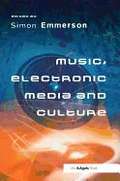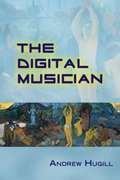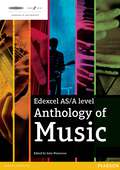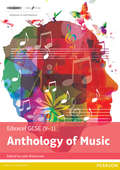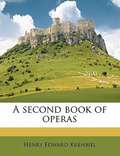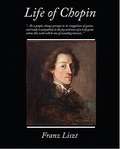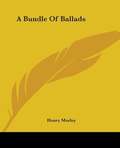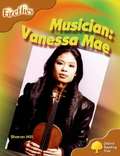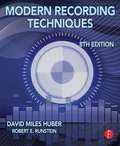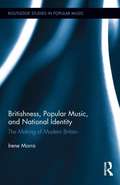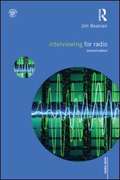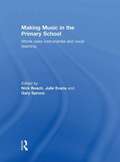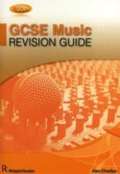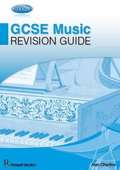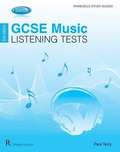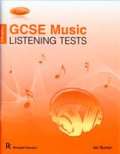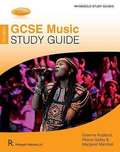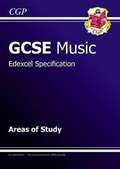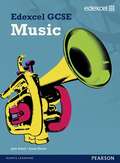- Table View
- List View
Music, Electronic Media And Culture (PDF)
by Simon EmmersonTechnology revolutionised the ways that music was produced in the twentieth century. As that century drew to a close and a new century begins a new revolution in roles is underway. The separate categories of composer, performer, distributor and listener are being challenged, while the sounds of the world itself become available for musical use. All kinds of sounds are now brought into the remit of composition, enabling the music of others to be sampled (or plundered), including that of unwitting musicians from non-western cultures. This sound world may appear contradictory - stimulating and invigorating as well as exploitative and destructive. This book addresses some of the issues now posed by the brave new world of music produced with technology.
Plan of an Orchestra layout (UEB Contracted)
This is a labelled plan (seen from above) of a classical orchestra, showing where the various instrumentalists and the conductor are placed on the concert platform. There is a locator dot shown, which will be at the top left of the page when the image is the right way up. The conductor is in the bottom centre of the page; he is the performer who is nearest the audience and stands with his back to them, facing the rest of the players further up the page. The various areas occupied by the instruments are labelled. The stringed instruments occupy the bottom third of the page with the woodwind and brass instruments further up the page. The percussion instruments are at the top left of the page.
Plan of an Orchestra layout (UEB Uncontracted)
This is a labelled plan (seen from above) of a classical orchestra, showing where the various instrumentalists and the conductor are placed on the concert platform. There is a locator dot shown, which will be at the top left of the page when the image is the right way up. The conductor is in the bottom centre of the page; he is the performer who is nearest the audience and stands with his back to them, facing the rest of the players further up the page. The various areas occupied by the instruments are labelled. The stringed instruments occupy the bottom third of the page with the woodwind and brass instruments further up the page. The percussion instruments are at the top left of the page.
The Digital Musician: Creating Music With Digital Technology
by Andrew HugillThe Digital Musician examines cultural awareness, artistic identity and musical skill through the prism of recent technological innovations. New technologies, and especially the new digital technologies, mean that anyone can create music without any musical training. How do we know what is good? This involves developing a personal aesthetic, an awareness of the context for one s work, specific musical and technical abilities and an individual identity. "
Edexcel As/a Level Anthology Of Music (PDF)
by Julia WintersonThe Pearson Edexcel AS/A level Anthology of Music introduces the AS and A level set works to a new generation of musicians and will inspire them to develop their music knowledge, understanding and skills and will help them prepare for their assessment. Published in partnership with Edition Peters and Faber Music, and edited by Julia Winterson, the printed Anthology contains: · printed music scores of all 53 new set works in a single volume · a preface to each score, setting the piece in context, highlighting key themes · listening awareness points and suggestions for wider listening · glossary of key terms used in each set work.
Edexcel Gcse (9-1) Anthology Of Music (PDF)
by Julia WintersonThe Pearson Edexcel GCSE Anthology of Music introduces the GCSE set works to a new generation of musicians and will inspire them to develop their music knowledge, understanding and skills and will help them prepare for their assessment. Published in partnership with Edition Peters and Faber Music, and edited by Julia Winterson, the printed Anthology contains: printed music scores of all 8 new set works in a single volume a preface to each score, setting the piece in context and highlighting key themes and listening awareness points glossary of key terms used in each set work.
Life of Chopin
by Franz LisztTo a people, always prompt in its recognition of genius, and ready to sympathize in the joys and woes of a truly great artist, this work will be one of exceeding interest. It is a short, glowing, and generous sketch, from the hand of Franz Liszt, (who, considered in the double light of composer and performer, has no living equal,) of the original and romantic Chopin; the most ethereal, subtle, and delicate among our modern tone-poets. It is a rare thing for a great artist to write on art, to leave the passionate worlds of sounds or colors for the colder realm of words; rarer still for him to abdicate, even temporarily, his own throne, to stand patiently and hold aloft the blazing torch of his own genius, to illume the gloomy grave of another: yet this has Liszt done through love for Chopin.
A Bundle of Ballads
by Henry MorleyHenry Morley (15 September 1822 – 1894) was a writer on English literature and one of the earliest Professors of English Literature. The son of an apothecary, he was born in Hatton Garden, London, educated at a Moravian school in Germany, and at King's College London, and after practicing medicine and keeping schools at various places, went in 1850 to London, and adopted literature as his profession. This book is a collection of his ballads.
Oxford Reading Tree, Stage 8, Fireflies: Vanessa Mae (PDF)
by Sharon HillBook band 10 white. Oxford level 8. Oxford Reading Tree Fireflies titles include a variety of topics covering all areas of the curriculum, from science to citizenship. The books are unchanged - they have a bright modern page design, and are illustrated with colour photographs. The teaching notes for the Oxford Reading Tree Fireflies levelled non-fiction books are full of practical suggestions for using the books, saving you hours of preparation time. They have been updated in line with the simple view of reading and the renewed Primary Framework for Literacy. They nowinclude guidance for group/guided reading, comprehension and word recognition, and assessment. These replace the existing Teaching Notes and Guided Reading Cards. The notes for parents/carers and teaching assistants have now been added to the inside covers. These notes replace the existing Take-Home Cards and support:* Comprehension* Word recognition
Modern Recording Techniques
by David Miles Huber Robert E. RunsteinMaster the tools and day-to-day practices of music recording and production. Learn the ins and outs of room acoustics and designing a studio. Gain techniques for mic placement and running a session. Get a solid grounding in both theory and industry practice. Modern Recording Techniques, the bestselling, authoritative guide to recording, provides everything you need to improve your craft. "If you're serious about recording--whether you're an amateur enthusiast, a student, a musician, or an audio professional, you'll find this book an informative, in-depth, cover-to-cover read and a useful reference manual. . . an excellent read and a must-have reference book. " - MusicTech magazine Expanded to include the latest digital audio technology, the eighth edition now has sections on touch technology, tablets, and newer connectivity options, such as Thunderbolt. It also includes revamped graphics throughout, and major updates of the sections covering DAWs, MIDI, and mastering. Whether you are just starting out or are looking for a step-up in the industry, Modern Recording Techniquesprovides an in-depth read on recording; it is a must-have for your audio bookshelf.
Routledge Studies in Popular Music: The Making of Modern Britain (1st edition)
by Irene MorraThis book offers a major exploration of the social and cultural importance of popular music to contemporary celebrations of Britishness. Rather than providing a history of popular music or an itemization of indigenous musical qualities, it exposes the influential cultural and nationalist rhetoric around popular music and the dissemination of that rhetoric in various forms. Since the 1960s, popular music has surpassed literature to become the dominant signifier of modern British culture and identity. This position has been enforced in popular culture, literature, news and music media, political rhetoric -- and in much popular music itself, which has become increasingly self-conscious about the expectation that music both articulate and manifest the inherent values and identity of the modern nation. This study examines the implications of such practices and the various social and cultural values they construct and enforce. It identifies two dominant, conflicting constructions around popular music: music as the voice of an indigenous English 'folk', and music as the voice of a re-emergent British Empire. These constructions are not only contradictory but also exclusive, prescribing a social and musical identity for the nation that ignores its greater creative, national, and cultural diversity. This book is the first to offer a comprehensive critique of an extremely powerful discourse in England that today informs dominant formulations of English and British national identity, history, and culture.
Interviewing For Radio
by Jim BeamanThis text presents an introduction to the techniques and skills of the radio interview. It offers advice on how to ask the right question and elicit a response, and guides readers through the use of equipment, and the mechanics of recording.
Making Music In The Primary School: Whole Class Instrumental And Vocal Teaching (PDF)
by Nick Beach Julie Evans Gary SpruceA guide for student and practising primary school teachers, instrumental teachers and community musicians involved in music with children. It explores teaching and learning music with the whole class and provides a framework for successful musical experiences with large groups of children. ISBN: 9780415561297 (hbk) ISBN: 9780415561303 (pbk) ISBN: 9780203834572 (ebk)
Making Music In The Primary School: Whole Class Instrumental And Vocal Teaching
by Nick Beach Julie Evans Gary SpruceA guide for student and practising primary school teachers, instrumental teachers and community musicians involved in music with children. It explores teaching and learning music with the whole class and provides a framework for successful musical experiences with large groups of children.
Interviewing For Radio (PDF)
by Jim BeamanThis text presents an introduction to the techniques and skills of the radio interview. It offers advice on how to ask the right question and elicit a response, and guides readers through the use of equipment, and the mechanics of recording.
The Handbook Of Music Therapy (PDF)
by Leslie Bunt Sarah HoskynsMusic therapists work with children and adults of all ages with wide-ranging health-care needs. This handbook traces the history of recent developments in music therapy and the range of current applications and outlines practical requirements for the work and some basic prerequisites for and philosophies of training. The Handbook of Music Therapy covers material encompassing clinical, practical and theoretical perspectives, and is divided into four main sections, including: * the recent evolution of music therapy as a paramedical discipline complementing the more traditional areas of child and adult health care * a clinical section including contributions from music therapy specialists in the fields of autism, adult learning disability, forensic psychiatry, neurology and dementia * a section on resources necessary to practise as a music therapist including musical illustrations and practical examples * a focus on issues pertinent to the life of the professional music therapist including job creation, supervision, further training and research. The Handbook of Music Therapy is illustrated with many case studies and clinical examples throughout, placed within a variety of different theoretical and philosophical perspectives. It will be invaluable to music therapists, other arts therapists and to clinicians such as speech and language therapists, psychotherapists, psychiatrists and social workers.
OCR GCSE Music Revision Guide (PDF)
by Alan CharltonThis revision guide presents all of the key information that you will need to know for your written exam. It includes a revision section on the elements of music, the most important facts about all of the topics in Areas of Study 2, 3 and 4, and test yourself questions that will allow you to check your knowledge. Areas of study include: Classical Romantic Pop Ballads Jazz Indian Classical Gamelan Choral classics African a cappella Baroque and Chamber music Waltz Tango Salsa Disco American line dance Irish Jig and Reel Bhangra Programme and Film music nbsp;
Edexcel GCSE Music: Revision Guide (PDF)
by Alan CharltonThis revision guide presents all of the key information that you will need to know for your written exam in a concise and friendly manner. It has been written by an experienced teacher and examiner in a clear and approachable style. It will help you achieve the best results possible.
Edexcel GCSE Music listening tests (PDF)
by Paul TerryListening questions to test your knowledge on all of the set works for Edexcel GCSE Music in the four Areas of Study. General questions to improve your listening skills. Helpful hints and advice to help you get a better grade.
OCR GCSE Music Listening Tests (PDF)
by Ian BurtonThis book contains a series of questions that will help you to prepare fully for Unit 4 (Listening Test) of your GCSE exam. It has been carefully written by an experienced teacher and examiner to match the requirements of the new OCR GCSE Music specification (for first teaching in 2009 and first exam in 2011). Contents include: Shared music Dance music Descriptive music
GCSE Music Study Guide OCR (PDF)
by Margaret Marshall Graeme Rudland Reece GalleyThis guide has been specifically written for the new OCR GCSE specification (for first teaching in 2009 and first exam in 2011). It will help you to succeed in all areas of your music GCSE. Topics include: Performing, Composing, Appraising and Listening Shared Music - Solo and Accompaniment Shared Music - Ensembles Dance Music Descriptive Music nbsp;
CGP GCSE Music AQA Specification: Areas of Study (PDF)
by Richard Parsons Robinson Heather Gregon John Deane Polly Cotterill Faye Stringer Elena Delaney Caley Simpson EdmundThis book takes you through everything you need to know about the Areas of Study for AQA's GCSE Music course. Every topic is broken down into simple, manageable chunks, so you know exactly what you need to learn.
CGP GCSE Music AQA Specification: Areas of Study (PDF)
by Richard Parsons Robinson Heather Gregon John Deane Polly Cotterill Faye Stringer Elena Delaney Caley Simpson EdmundThis book takes you through everything you need to know about the Areas of Study for AQA's GCSE Music course. Every topic is broken down into simple, manageable chunks, so you know exactly what you need to learn.
Edexcel GCSE Music (PDF)
by Jonny Martin John ArkellEdexcel's own resources for the new 2009 GCSE specification. Tailored to the new specification, the Edexcel GCSE Music Student Book is written by chief and principal examiners and subject experts. It focuses on developing students' listening and appraising skills around the 12 set-pieces, and includes performance and composing tasks within all four Areas of Study to ensure students develop the key musical skills assessed in the coursework element. Exam and coursework guidance is provided, including examzone, to help students prepare for the exam and fulfil their potential. ResultsPlus data advises students on common errors and how to improve their exam responses.
